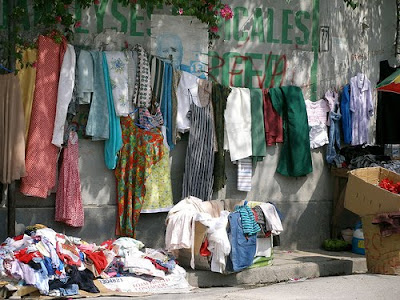photo by HannaRose Shell
Most of the clothing we donate to Goodwill, etc does not actually sell through the stores. The best stuff gets sorted out to sell here in the USA, which I am glad to partake of at $3.50 per shirt, but the rest gets bought by exporters for pennies per pound (3 cents even!) who bale it up and send it to third world countries where it is resold to dealers for a few pennies more per pound, then sold again to shops and peddlers for a few pennies more and so on. Americans buy clothes with a disposable mindset that creates a constant flow of cast-offs in search of a market. It certainly isn't given away like you might expect. George Packer writes in his 2002 NY Times magazine article on the subject: "A long chain of charity and commerce binds the world's richest and poorest people in accidental intimacy." That chain makes some interesting twists and turns.photo by HannaRose Shell
Bertozzi & Shell were inspired by the Packer article to delve into this almost hush-hush industry. In their film they meld archival footage of Jewish rag peddlers from Eastern Europe who migrated to the US in the early 20th century with new imagery of the seconhand clothing trade in Haiti. Exerpts from the memoir of a rag peddler are read by his grandson and artfully interwoven with sound bytes from a Hatian-American radio show asking callers "What is pepe?" In this poorest country in the western hemisphere, new clothing is almost unheard of. The boatloads of clothing and other seconhand articles that arrive constantly in Port Au Prince is referred to as "pepe", a slang term derived from the early peddlers calling out "paix! paix!" to calm the feeding frenzy over new arrivals. Other nicknames for it are "Kennedy", "Reagan", "Goodwill", or if it's an exceptionally good piece, "Hollywood pepe".After the pepe arrives, it gets sorted, filtered and redistributed through an intricate network of entrepreneurs, peddlers, and seamstresses. Even stained or torn goods, can find use as rags upholstery stuffing, or even patchwork art as shown here from Vanessa Bertozzi's flickr set.
photo by Vanessa Bertozzi
Upcycling at it's vibrant best. photo by Vanessa Bertozzi
What is interesting to me is how creativity can arise out of need. Hatians are very resourceful at re-purposing and resusing. They have to be- nothing is new here. There are no chain stores.photo by Vanessa Bertozzi
Believe it or not, old-style foot-pedal sewing machines are preferred in Haiti because of the frequent power outages. photo by Vanessa Bertozzi
This seamstress, struggling to sell her new designs, explains how her own shirt is pepe with shaping added through darts and sleeves modified from long to short. It's a love-hate relationship. The pepe is irresistible because of the cheap price of it, yet it beats out any local apparel industry except as it relates to modifying the pepe. It brings to mind our American addiction to cheap products from big box stores and how it has squelched our own local industries.photo by HannaRose Shell
I just like this interior, likely filled with pepe, from Hanna Rose Shell's flickr set. It looks like something out of the beloved, defunct Domino Magazine.These images are all of Haiti in better times. It's hard to imagine this poor country enduring earthquake devastation on top of it all. Go here if you are interested in contributing to Habitat for Humanity's resconstuction efforts in Haiti.















 I used to be a clothing designer in New York City, then I chucked it all to start a family. I stay busy as an independent designer of kids’ clothing and textiles for various companies, and for my own label “chirp & bloom”. This is my personal blog, where I keep my notes on all things vintage, green, handmade, indie, kid-friendly, and whatever else inspires me to keep evolving. Just for fun, I feature artisans I discover at indie craft shows and share sewing and other DIY projects through tutorials. Thanks for visiting!
I used to be a clothing designer in New York City, then I chucked it all to start a family. I stay busy as an independent designer of kids’ clothing and textiles for various companies, and for my own label “chirp & bloom”. This is my personal blog, where I keep my notes on all things vintage, green, handmade, indie, kid-friendly, and whatever else inspires me to keep evolving. Just for fun, I feature artisans I discover at indie craft shows and share sewing and other DIY projects through tutorials. Thanks for visiting!





 All personal designs, images, and written words in this blog are copyrighted by Rebecca Harkin unless otherwise credited. Feel free to link back to my posts all you want, but please do not copy my photos or words without my permission.
All personal designs, images, and written words in this blog are copyrighted by Rebecca Harkin unless otherwise credited. Feel free to link back to my posts all you want, but please do not copy my photos or words without my permission.
1 comment:
Great post, Becky. I had read that NY Times article and thought is was fascinating; not surprised that it inspired a documentary.
Post a Comment